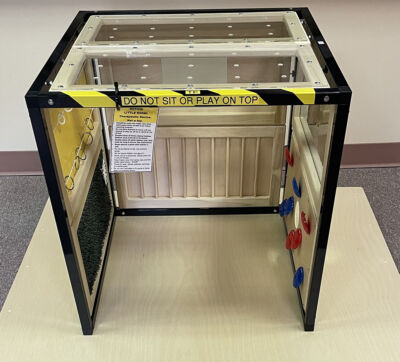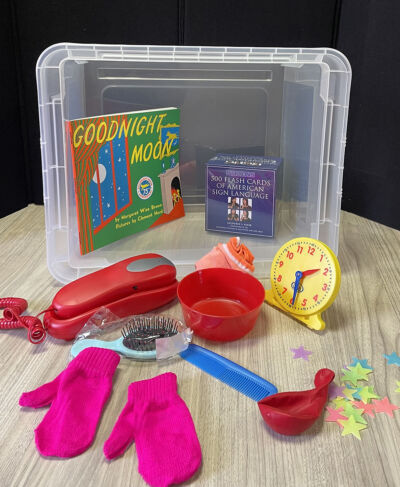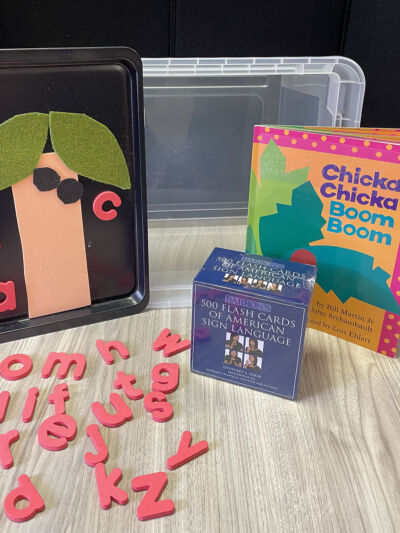Blindness/Low Vision
An impairment in vision that, even with correction, adversely affects a child’s educational performance.
Deafness
A hearing impairment so severe that a child is impaired in processing linguistic information through hearing, with or without amplification, that adversely affects a child’s educational performance.
Hard of Hearing
An impairment in hearing, whether permanent or fluctuating, that adversely affects a child’s educational performance.
Deafblindness
Simultaneous hearing and visual impairments, the combination of which causes such severe communication and other developmental and educational needs that they cannot be accommodated in a special education program solely for children with deafness or children with blindness.
Blindness and Low Vision
Fact Sheet
This fact sheet includes the definition of blindness and low vision, descriptions of unique evaluations for students with blindness or low vision, possible signs and characteristics of visual problems as well as instructional strategies.
West Virginia VI Resources
Welcome to West Virginia’s VI Resources website connecting families and professionals to local, state and national resources. Funded by the Greater Kanawha Valley Foundation, this collaborative website is sponsored by the West Virginia VI Advisory Committee. Its purpose is to provide the most up-to-date information or links to information pertaining to children and youth who are blind or have low vision for the benefit of the families and children we serve.
The WV VI Advisory Committee was established in 2007 in an effort to coordinate and enhance the educational services to children who are blind or have low vision and their families in West Virginia. Collaborative partners include state leaders in the field of visual impairments from the West Virginia Department of Education, Children’s Vision Rehabilitation Project, Marshall University, West Virginia University, West Virginia School for the Blind, Instructional Resource Center, and Harrison County Board of Education.
- IDEA and 504 Frequently Asked Questions
- West Virginia Instructional Resource Center
- American Foundation for the Blind (AFB)
- American Printing House (APH)
- WV Library Commission
- National Federation for the Blind
- National Braille Press
- National Consortium on Deaf-Blindness (NCDB)
- Texas School for the Blind and Visually Impaired (TSBVI)
- Perkins School for the Blind
- Bookshare.org
- Braille Authority of North American (BANA)
- Division on Visual Impairments
- WV Expanded Core Curriculum
- IRC Textbook Request Form (Preferred)
- IRC Supplemental Registration Form (REVISED JAN. 2018)
- IRC Aids and Equipment Request Form (Preferred)
Deafness/Hard of Hearing
Fact Sheet
Resources
A student who is deaf is one who exhibits a hearing loss so severe that the student is impaired in processing linguistic information through hearing, with or without amplification, which adversely affects a student’s educational performance. This student relies primarily on vision to access spoken communication.
A student who is hard of hearing is one who exhibits a hearing loss, whether permanent or fluctuating, that adversely affects a student’s educational performance but that is not included under the definition of deafness. This student relies primarily on hearing to access spoken communication.
Education Sign Language Interpreters Guidance for WV Schools
Educators
- ASL Developmental Checklist
- The Expanded Core Curriculum for Students Who Are Deaf or Hard of Hearing
- Cochlear Implant Troubleshooting
- ECC-DHH Checklist
- ECC-DHH Needs Assessment
- ECC-DHH Worksheet
- Hearing Aid Check
- LMH 10 Sound Test
- IDEA and 504 Frequently Asked Questions
- IEP Consideration Factors for Students who is Deaf or Hard of Hearing
- IEP Consideration Factors for Students Who Are Deaf and Hard of Hearing Insructions
- IEP Accommodations and Modifications Checklist
- WV Schools for the Deaf and Blind
- Auditory Skills Checklist
- Comprehensive Language Evaluation
- Assessment Tool
Interpreters
- Template for Professional Development and Verification
- Paraprofessional Certificate: Educational Interpreter
Families
- Deaf Child’s Bill of Rights
- Hands and Voices WV
- Accessible Educational Materials for Students Who Are Deaf or Hard of Hearing
Other Deafness/Hard of Hearing Resources:
- AIM on YouTube
- American Sign Language Teachers Association
- Boys Town National Research Hospital
- Classroom Interpreting
- Clerc Center
- Closed Captioning
- Deaf Education Website
- Gallaudet University Press
- Hands and Voices National
- Hands and Voices West Virginia
- Harris Communications
- Laurent Clerc National Deaf Education Center
- National Association of the Deaf
- National Cued Speech Association
- Registry of Interpreters for the Deaf
- Signing Online
- Support Success for Children with Hearing Loss
- WV Commission for the Deaf and Hard of Hearing
- WV Division of Rehabilitation Services
- The Luke Lee Listening, Language and Learning Lab at Marshall University
Deafblindness or Combined Vision and Hearing Loss
A student who is deafblind is one who exhibits both a vision and a hearing loss, the combination of which causes such severe communication and other developmental and educational needs that he/she cannot be accommodated in a special education program designed solely for students with deafness or blindness or students who are hard of hearing or partially sighted.
This project serves children birth to age 21 with combined vision and hearing loss. The definition includes infants and toddlers who:
-
from birth through age 2 who are experiencing developmental delays in hearing and vision,
-
have a diagnosed physical or mental condition that has a high probability of resulting in developmental delays in hearing and vision, or
-
are at risk of having substantial developmental delays in hearing and vision if early intervention services are not provided.
Deafblindness Fact Sheet
This fact sheet includes the definition of deafblindness, the implications of deafblindness as well as important instructional strategies.
Resources
The Little Room

The Little Room and Resonance Board were created by Dr. Lilli Nielsen. These are both tools to be used with Active Learning, which was also developed by Dr. Nielsen. Dr. Nielsen used this approach when working with students who were blind or deafblind. The active learning approach emphasized that all children learn best when they are active participants. The use of the little room and resonance board promotes active learning and the development of the following skills:
- Spatial awareness of objects in relation to the child’s body
- Motor skills – grasping and letting go of objects; moving to make things happen
- Cognitive skills
- Auditory skills
The Little Room & Resonance Board will be available for loan following the completion of a webinar on Active Learning.
Adapted Book Boxes
Goodnight Moon

Chicka Chicka Boom Boom

Contact Debbie Adams, deafblind coordinator, to check out Little Rooms and adapted book boxes.
Deafblind Coordinator/Project Director
Debbie Adams (Email: dadams@k12.wv.us)
Cortical Visual Impairment
CVI Training Materials
Recognizing that CVI is the leading cause of visual impairment among children and cognizant of the need for highly qualified interventionists, four state deaf-blind projects embarked on a ten-year collaboration known as the “Cortical Visual Impairment Community of Practice”. The Deaf-Blind Projects from Delaware, Maryland, Vermont, and West Virginia developed and implemented an innovative and successful professional development program which trained an interdisciplinary team of “CVI Mentors” from each state in screening, assessment, program planning and intervention There are four CVI Mentors in West Virginia. These mentors are among the nation’s first professionals to undergo training of this depth and magnitude in this specialty area. Each has received certification of completion of the entire training program and has successfully mastered CVI competencies established in the program. This was followed by training additional “CVI Partners” to also assist in their states.
This website has been created by West Virginia’s CVI Mentors to help service providers and families gain more information about CVI. Videos of previous training, interviews with students are included. You can test your knowledge of CVI to see if you are ready to do assessments yourself!
- CVI – Special Topics
- CVI-A Basic Understanding
- CVI Assessment
- Are You Ready? Test your Knowledge and Skills
- Personal Perspective
Watch interviews of students with CVI, family members, and teacher of the visually impaired.
These programs in West Virginia have been funded by WVDE SenseAbilities Project, The Greater Kanawha Valley Foundation and WV Birth to Three.
Other Resources
- Guidelines for Modifying Books for Students in Phases I, II, III
- AAC Systems for Students with CVI and Multiple Disabilities
- Effective Access to Communication and Literacy for Students with Visual and Multiple Disabilities
- WV Expanded Core Curriculum
Contact Information
Debbie Adams, dadams@k12.wv.us, Deafblind Coordinator
